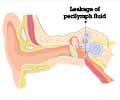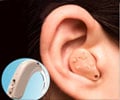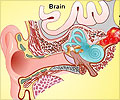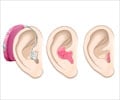An estimated 35 percent of U.S. adults age 40 and older have vestibular dysfunction (inner ear balance disorders), and those who do may have a higher risk of falling, according to
A report in the May 25 issue of Archives of Internal Medicine, one of the JAMA/Archives journals, has revealed that some 35 percent of U.S. adults age 40 and older have inner ear balance disorders and are hence at a higher risk of falling.
The vestibular system helps control an individual's balance, according to background information in the article. The two vestibular organs, within the temporal bone at the side and base of the skull, provide input to the brain about head motion and orientation relative to gravity. "Vestibular dysfunction is typically characterized by vertigo (i.e., an illusory sense of motion) and imbalance owing to disturbances in gaze and postural stability," the authors write. "In some cases, vestibular dysfunction can culminate catastrophically in a fall, which is associated with serious injury and restricted mobility and ranks among the leading causes of death among older individuals."Despite these concerns, little has previously been known about the prevalence of vestibular dysfunction in the United States, in part because of the difficulty of diagnosis. Yuri Agrawal, M.D., and colleagues at the Johns Hopkins University School of Medicine, Baltimore, analyzed data from a nationally representative sample of 5,086 adults who participated in the 2001-2004 National Health and Nutrition Examination Surveys. Participants completed a balance questionnaire, which determined history of dizziness and falls, and underwent in-person balance testing that involved standing on different surfaces under varying conditions (for instance, with their eyes closed).
As determined by these tests, the overall prevalence of vestibular dysfunction in the U.S. population aged 40 and older from 2001 through 2004 was 35.4 percent. "Odds of vestibular dysfunction increased significantly with age, were 40.3 percent lower in individuals with more than a high school education and were 70 percent higher among people with diabetes mellitus," the authors write.
Individuals with vestibular dysfunction were more likely to report having dizziness and a history of falls. The 26.8 percent of participants who had symptoms of vestibular dysfunction, including dizziness, had an eight-fold increase in the odds of falling. Individuals who were asymptomatic also had significantly increased odds of falling. In addition, participants with vestibular dysfunction had an increased risk of hearing loss, which likely reflects the similar anatomic locations of the vestibular and hearing organs as well as their common blood supply.
"These findings suggest the importance of diagnosing and treating vestibular deficits to reduce the burden of fall-related injuries and deaths," the authors write. "Given the high prevalence of this impairment, notably among the elderly, and the extraordinary costs associated with falls (exceeding $20 billion annually), screening for vestibular dysfunction in assisted living or nursing home facilities, for example, could be a life-saving and cost-effective practice. Screening may be particularly effective in groups at heightened risk of vestibular dysfunction, specifically non-whites, individuals with less than a high school education, people with diabetes and the hearing impaired."
Source-Eurekalert
RAS















